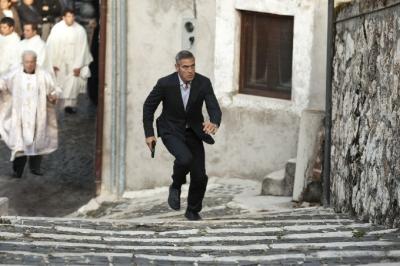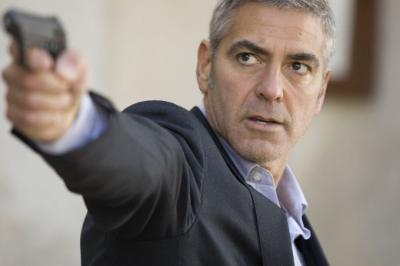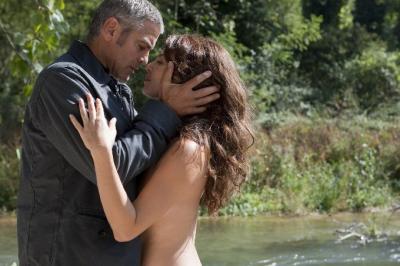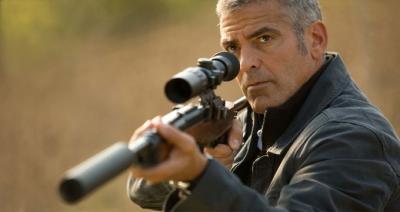By: debbie lynn elias
 Anyone familiar with Anton Corbijn’s photography recognizes and appreciates his austere, simple, yet powerful, elegance – particularly with his black & white or tint works. He has a very metaphoric eye which enables him to tell an entire story with one frame, evoking and provoking introspective thought and emotion, a gift that bodes well for his transition to film. He needs no words to tell a story, something that makes him the perfect director for THE AMERICAN. Based on Martin Booth’s novel “A Very Private Gentleman”, together with George Clooney, Corbijn weaves a web of psychological and emotional intrigue, reliant on Clooneyfs raw talent and Corbijn’s metaphoric visual aesthetic. The result is often thrilling, always mysterious and taut, but even more than that, intriguing and riveting as we delve into the mind’s eye of a samurai.
Anyone familiar with Anton Corbijn’s photography recognizes and appreciates his austere, simple, yet powerful, elegance – particularly with his black & white or tint works. He has a very metaphoric eye which enables him to tell an entire story with one frame, evoking and provoking introspective thought and emotion, a gift that bodes well for his transition to film. He needs no words to tell a story, something that makes him the perfect director for THE AMERICAN. Based on Martin Booth’s novel “A Very Private Gentleman”, together with George Clooney, Corbijn weaves a web of psychological and emotional intrigue, reliant on Clooneyfs raw talent and Corbijn’s metaphoric visual aesthetic. The result is often thrilling, always mysterious and taut, but even more than that, intriguing and riveting as we delve into the mind’s eye of a samurai.
A quiet fire, a beautiful woman, a handsome man. Classical music softly playing in the background as the couple quietly sip their drinks. Jack has a burning intensity and fierceness with a touch of fear on his face. He seems out of touch and a thousand miles away. As the couple venture outdoors, we are greeted with the pristine beauty and purity of a snow covered winter wonderland. The silence is almost deafening until Ingrid begins to prattle on about shopping. Suddenly, Jack, always looking, always watching his back, sees a disturbing sight. Tracks in the untouched freshly fallen snow. Animals in the area walk in pairs. These tracks are single. Instantly, Jack’s instincts kick in and he and Ingrid take off running in the knee deep snow for cover by a rocky cliff. Swiftly, silently, Jack pulls a gun from his pocket. A gunshot whirs past them, hitting the rock,. With the swiftness and quiet of a gazelle, Jack slides around for a better look at the shooter. More shots. Jack fires. He hits his target. A man falls, dropping onto the ground from above. Barking orders at Ingrid, Jack then pivots, realizing something isn’t right. He aims. He shoots. Ingrid’s red blood spills out onto the white snow. Who is Jack and what have we just witnessed?

Leaving the tragedy of Sweden behind him, Jack heads for Italy. Calling his “boss” for instructions, we learn Jack is an assassin. A loner by trade, Jack is at an emotional crossroads. Was Ingrid a set-up? Did he let his guard down by allowing her into his life? Is he and his way of life in danger of extinction? Itfs time to get out of the business. But his boss wants him to do one more job, just one more and it involves no shooting; merely making and delivering a custom weapon with the long-range precision of a rifle, the firepower of a sub-machine gun, quiet and able to fit in a cosmetic valise.
Suspicious of everyone and everything, Jack deviates from his instructions and holes up in the tiny little village of Castel del Monte high in the mountainous region of Abruzzo. Quietly working on his assignment, Jack finds he is unable to hide his true identity much longer. A very intuitive and kindly local priest, hiding his own secrets, recognizes a kindred spirit and questions Jack and his cover as photographer of landscapes, nature and architects. He also realizes Jack is not who he seems when Jack maintains he “can’t work machines” and thus no cell phone, fax, computer, etc., yet can gerry-rig a non-functioning piston in the priest’s car with just a piece of wire. With tacit mutual respect, the two strike a unique relationship.

Needing companionship to squelch some of his loneliness and his uneasiness, Jack turns to a beautiful prostitute named Clara. Like minded in their need for solitude and anonymity of their true identities given the nature of their work, they are a perfect match. Mechanical and intense in satisfying their physical needs, this professional relationship begins to get personal as Jack, using the pseudonym Eduardo, starts to care about pleasing Clara while Clara takes note of little personal touches in Jack/Eduardo, like his tattoo of an endangered butterfly. What if they just run away? Start a new life. Can that possibly happen?

And while Jack starts to get a taste of what life might be like once he gets out of “the business”, he faces growing suspicion and fear as some shady looking characters appear in town while his “client” gives him cause for trepidation.
This is a George Clooney we haven’t seen before. Sparse on words (if he has 200-300 in the whole film I would be surprised), he relies on his facial expression to tell the story and describe Jack. Clooney is mesmerizing. Carrying a tortuous expression for the bulk of the film, you can read fear and paranoia in his eyes. Like a pupa maturing into an adult butterfly, through Clooneyfs eyes we an inner emotional metamorphosis that gives rise to moments of shared beauty, humanizing a steely killer. He has a methodical and meticulous deliberateness to every action, every movement that is fascinating to watch executed.
Violante Placido (who is Michael Corleone’s daughter in “The Godfather”) charms as Clara and while we girls get Clooney’s naked butt, you guys will also get to see plenty of Placido in all her glory. What I find interesting in her performance is the innocence and joyful girlishness she brings to Clara balanced with an anonymous toughness. Paolo Bonacelli as Father Benedetto lend a moral conscience to the film that sparks some of Jackfs metamorphosis. Bonacelli and Clooney together have an interesting dynamic to watch. Thekla Reuten tackles the role of Mathilde, Jack’s final client. Her performance is the one that doesn’t really hold up and comes across as lackluster.
Adapted by Rowan Joffe from Martin Booth’s 1990 novel “A Very Private Gentleman”, THE AMERICAN is more a psychologically thrilling character study than thriller. Completely void of any backstory, the very nature of the film raises the who, what, where, when, why and how of Jack’s background – after all, becoming an assassin is not something one arbitrarily decides to do on waking up one morning. But what is constructed is, like the character of Jack, meticulously detailed not by word, but by powerful imagery. The taciturn nature of the film and sparse dialogue reveal just enough for an understanding of what the visual then expands upon.
The first thing one notices with THE AMERICAN is the perfect framing of each shot. The next thing one notices (after Clooney’s eyes, abs and naked butt – yes, ladies!!) is the eloquence of Corbijn’s voice through use of overhead shots of Castel del Monte. Being a village up in the mountains, the roads within town are cobblestoned and circular, appearing as if spiraling to the heavens or descending into the depths of hell, but no matter which way, endlessly intertwining lending to the metaphoric confusion within Jack. Further complimenting the story is wide lensing of open roadways, filled with twists and turns. On the flip side, Corbijn also celebrates the expansiveness and emptiness of the world with the panoramic snow covered scenes in Sweden, only to then dazzle with the intimacy of a sunlit stream nestled next to an alcove of leafy green trees. Clearly, his talents as a photographer and work in music videos have all led to this project which exceeds his prior feature, “Control” and my expectations with THE AMERICAN. Unfortunately, however, there are some missteps within the editing, resulting in some actions that are out of place for the character and/or may impact the direction of the story but then never addressed, leaving a few holes. One such hole involves Jack and some shoes.
While not one the more famous cinematographers in the business today, although one of the most talented, Martin Ruhe has a visual gift to equal that of Corbijn, making him a perfect cinematic partner on THE AMERICAN. As with his work in “The Countess” and “Harry Brown”, Ruhe excels with use of light and shadow, and particularly with pale tint and night work, giving great edginess and tension to any scene. Here, the night scenes within the cobbled alleys of Caste del Monte are nail-bitingly magical with the reflection of deep lantern yellows mired in darkness and mirrored on the dampness of the cobbled ground texture. Simply stunning work.
Adding to the thematic mood is an exemplary score by Herbert Gronemeyer.
Meticulously crafted with the care and attention equal to that of Jack himself constructing a long-range high-powered weapon, THE AMERICAN is a well-acted, methodical, contemplative and visually interpretive work that, like Jack’s namesake butterfly, is an endangered form of filmmaking.
Jack/Eduardo – George Clooney
Clara – Violante Placido
Father Benedetto – Paolo Bonacelli
Directed by Anton Corbijn. Written by Rowan Joffe based on the novel by Martin Booth.












